A Denoising Method for Randomly Clustered Noise in ICCD Sensing Images Based on Hypergraph Cut and Down Sampling
Abstract
:1. Introduction
2. Related Models
2.1. Hypergraph and Hypergraph Cut
2.2. Spectral Clustering
2.3. Robust Principal Component Analysis
3. Framework of the Proposed Denoising Algorithm
4. The Denoising Algorithm for ICCD Sensing Images
4.1. Over-Segmentation with the Watershed Algorithm
4.2. Down-Sampling and Up-Sampling for Residual Estimation
- (a)
- Calculate the scale of each patch, and then classify them into several classes according to their scale values with the k-means method [27].
- (b)
- For each class, determine the mean of patch scales as the sampling scale in the down-sampling process.
- (c)
- Denoise the image after each down-sampling with the general block-matching and 3D filtering (BM3D) [28] algorithm;
- (d)
- Up-sample each low-resolution image to the original size to obtain a recovered ICCD image.
4.3. Construction of Hyperedges and Their Weights
4.4. Patch Classification and Recovery
4.5. Post-Processing by RPCA
5. Experiments and Analysis
5.1. Parameter Determination in Constructing the Hypergraph
5.2. Verify the Effectiveness of the Hypergraph Cut
5.3. Verify the Performance of the Proposed Denoising Algorithm
5.4. Verify the Effectiveness of the RPCA in the Denoising Process
5.5. Time Complexity of the Proposed Algorithm
6. Conclusions
Acknowledgments
Author Contributions
Conflicts of Interest
References
- Brown, M.; Hamilton, S. Comparison of Gen II, Gen III filmed and Gen III filmless image intensified charge-coupled device cameras. In Proceedings of the 2003 Conference on Lasers and Electro-Optics Europe (CLEO), Munich, Germany, 1 January 2003. [Google Scholar]
- Wang, F.; Wang, Y.; Yang, M.; Zhang, X.; Zheng, N. A Denoising Scheme for Randomly Clustered Noise Removal in ICCD Sensing Image. Sensors 2017, 17, 233. [Google Scholar] [CrossRef] [PubMed]
- Shao, L.; Yan, R.; Li, X.; Liu, Y. From Heuristic Optimization to Dictionary Learning: A Review and Comprehensive Comparison of Image Denoising Algorithms. IEEE Trans. Cybern. 2014, 44, 1001–1013. [Google Scholar] [CrossRef] [PubMed]
- Huiying, D.; Xuejing, Z. Detection and removal of rain and snow from videos ased on frame difference method. In Proceedings of the 27th Chinese Control and Decision Conference (2015 CCDC), Qingdao, China, 23–25 May 2015. [Google Scholar]
- Son, C.-H.; Zhang, X.-P. Rain removal via shrinkage of sparse codes and learned rain dictionary. In Proceedings of the 2016 IEEE International Conference on Multimedia & Expo Workshops (ICMEW), Seattle, WA, USA, 11–15 July 2016. [Google Scholar]
- Kang, L.W.; Lin, C.W.; Fu, Y.H. Automatic Single-Image-Based Rain Streaks Removal via Image Decomposition. IEEE Trans. Image Process. 2012, 21, 1742–1755. [Google Scholar] [CrossRef] [PubMed]
- Fu, Y.H.; Kang, L.-W.; Lin, C.-W.; Hsu, C.-T. Single-frame-based rain removal via image decomposition. In Proceedings of the 2011 IEEE International Conference on Acoustics, Speech and Signal Processing (ICASSP), Prague, Czech Republic, 22–27 May 2011. [Google Scholar]
- Huang, D.-A.; Kang, L.-W.; Yang, M.-C.; Lin, C.-W.; Frank Wang, Y.-C. Context-Aware Single Image Rain Removal. In Proceedings of the 2012 IEEE International Conference on Multimedia and Expo (ICMEW), Melbourne, Australia, 9–13 July 2012. [Google Scholar]
- Liu, F.; Yang, J.; Yue, H. Moire pattern removal from texture images via low-rank and sparse matrix decomposition. In Proceedings of the 2015 Visual Communications and Image Processing (VCIP), Singapore, 13–16 December 2015. [Google Scholar]
- Goto, H.; Aso, H. Screen pattern removal for character pattern extraction from high-resolution color document images. In Proceedings of the 17th International Conference on Pattern Recognition (ICPR 2004), Cambridge, UK, 26 August 2004. [Google Scholar]
- Ionita, G.M.; Coltuc, D.; Stanciu, S.G.; Tranca, D.E. Automatic moire; pattern removal in microscopic images. In Proceedings of the 2015 19th International Conference on System Theory, Control and Computing (ICSTCC), Cheile Gradistei, Romania, 14–16 October 2015. [Google Scholar]
- Brox, T.; Kleinschmidt, O.; Cremers, D. Efficient Nonlocal Means for Denoising of Textural Patterns. IEEE Trans. Image Process. 2008, 17, 1083–1092. [Google Scholar] [CrossRef] [PubMed]
- Buades, A.; Coll, B.; Morel, J.M. A non-local algorithm for image denoising. In Proceedings of the 2005 IEEE Computer Society Conference on Computer Vision and Pattern Recognition (CVPR’05), San Diego, CA, USA, 20–25 June 2005. [Google Scholar]
- Agrawal, M.; Doermann, D. Stroke-Like Pattern Noise Removal in Binary Document Images. In Proceedings of the 2011 International Conference on Document Analysis and Recognition, Beijing, China, 18–21 September 2011. [Google Scholar]
- Shirai, K.; Akita, M.; Okamoto, M.; Tanikawa, K.; Akiyama, T.; Sakaguchi, T. Removal of Background Patterns and Signatures for Magnetic Ink Character Recognition of Checks. In Proceedings of the 2012 10th IAPR International Workshop on Document Analysis Systems, Gold Cost, Australia, 27–29 March 2012. [Google Scholar]
- Georgiev, M.; Bregović, R.; Gotchev, A. Fixed-Pattern Noise Modeling and Removal in Time-of-Flight Sensing. IEEE Trans. Instrum. Meas. 2016, 65, 808–820. [Google Scholar] [CrossRef]
- Maggioni, M.; Sánchez-Monge, E.; Foi, A. Joint Removal of Random and Fixed-Pattern Noise through Spatiotemporal Video Filtering. IEEE Trans. Image Process. 2014, 23, 4282–4296. [Google Scholar] [CrossRef] [PubMed]
- Cornelis, B.; Yang, H.; Goodfriend, A.; Ocon, N.; Lu, J.; Daubechies, I. Removal of Canvas Patterns in Digital Acquisitions of Paintings. IEEE Trans. Image Process. 2017, 26, 160–171. [Google Scholar] [CrossRef] [PubMed]
- Kang, L.-W.; Yeh, C.-H.; Chen, D.-Y.; Lin, C.-T. Self-learning-based signal decomposition for multimedia applications: A review and comparative study. In Proceedings of the Signal and Information Processing Association Annual Summit and Conference (APSIPA), Siem Reap, Cambodia, 9–12 December 2014. [Google Scholar]
- Vincent, L.; Soille, P. Watersheds in digital spaces: An efficient algorithm based on immersion simulations. IEEE Trans. Pattern Anal. Mach. Intell. 1991, 13, 583–598. [Google Scholar] [CrossRef]
- Bernhard, S.; John, P.; Thomas, H. Learning with Hypergraphs: Clustering, Classification, and Embedding. In Proceedings of the 2006 Conference on Advances in Neural Information Processing Systems 19, Vancouver, BC, Canada, 4–7 December 2007; MIT Press: Cambridge, MA, USA, 2007; pp. 1601–1608. [Google Scholar]
- Jianbo, S.; Malik, J. Normalized cuts and image segmentation. IEEE Trans. Pattern Anal. Mach. Intell. 2000, 22, 888–905. [Google Scholar] [CrossRef]
- Ng, A.Y.; Jordan, M.I.; Weiss, Y. On Spectral Clustering: Analysis and an algorithm. Proc. Adv. Neural Inf. Process. Syst. 2002, 14, 849–856. [Google Scholar]
- Candès, E.J.; Li, X.; Ma, Y.; Wright, J. Robust principal component analysis? J. ACM 2011, 58, 1–37. [Google Scholar] [CrossRef]
- Lin, Z.; Chen, M.; Ma, Y. The Augmented Lagrange Multiplier Method for Exact Recovery of Corrupted Low-Rank Matrices. arXiv, 2010; arXiv:1009.5055. [Google Scholar]
- Lin, Z.; Ganesh, A.; Wright, J.; Wu, L.; Chen, M.; Ma, Y. Fast Convex Optimization Algorithms for Exact Recovery of a Corrupted Low-Rank Matrix. JMBA 2009, 56, 707–722. [Google Scholar]
- Kanungo, T.; Mount, D.M.; Netanyahu, N.S.; Piatko, C.D.; Silverman, R.; Wu, A.Y. An efficient k-means clustering algorithm: Analysis and implementation. IEEE Trans. Pattern Anal. Mach. Intell. 2002, 24, 881–892. [Google Scholar] [CrossRef]
- Dabov, K.; Foi, A.; Katkovnik, V.; Egiazarian, K. Image Denoising by Sparse 3-D Transform-Domain Collaborative Filtering. IEEE Trans. Image Process. 2007, 16, 2080–2095. [Google Scholar] [CrossRef] [PubMed]
- Elad, M.; Aharon, M. Image Denoising Via Sparse and Redundant Representations over Learned Dictionaries. IEEE Trans. Image Process. 2006, 15, 3736–3745. [Google Scholar] [CrossRef] [PubMed]
- Portilla, J.; Strela, V.; Wainwright, M.J.; Simoncelli, E.P. Image denoising using scale mixtures of Gaussians in the wavelet domain. IEEE IEEE Trans. Image Process. 2003, 12, 1338–1351. [Google Scholar] [CrossRef] [PubMed]
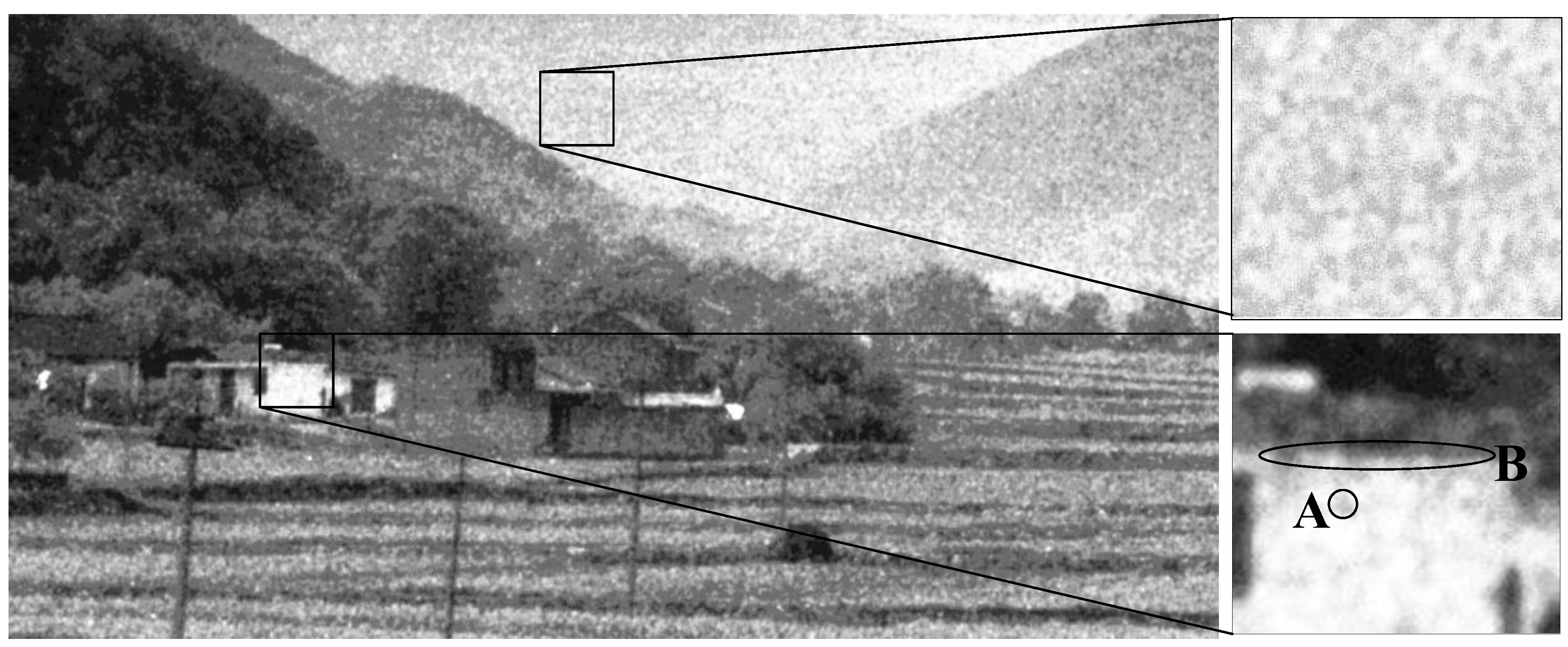


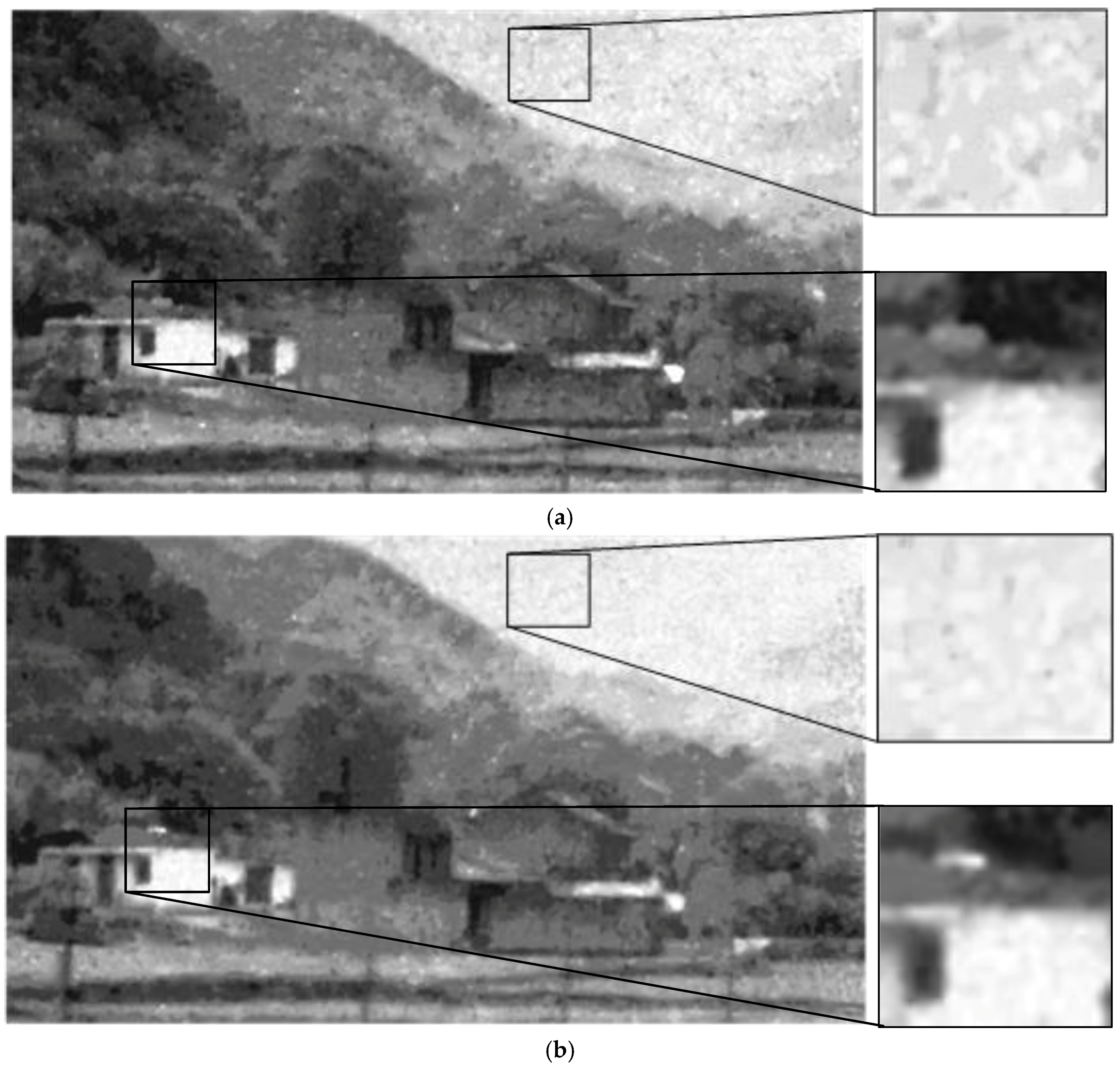
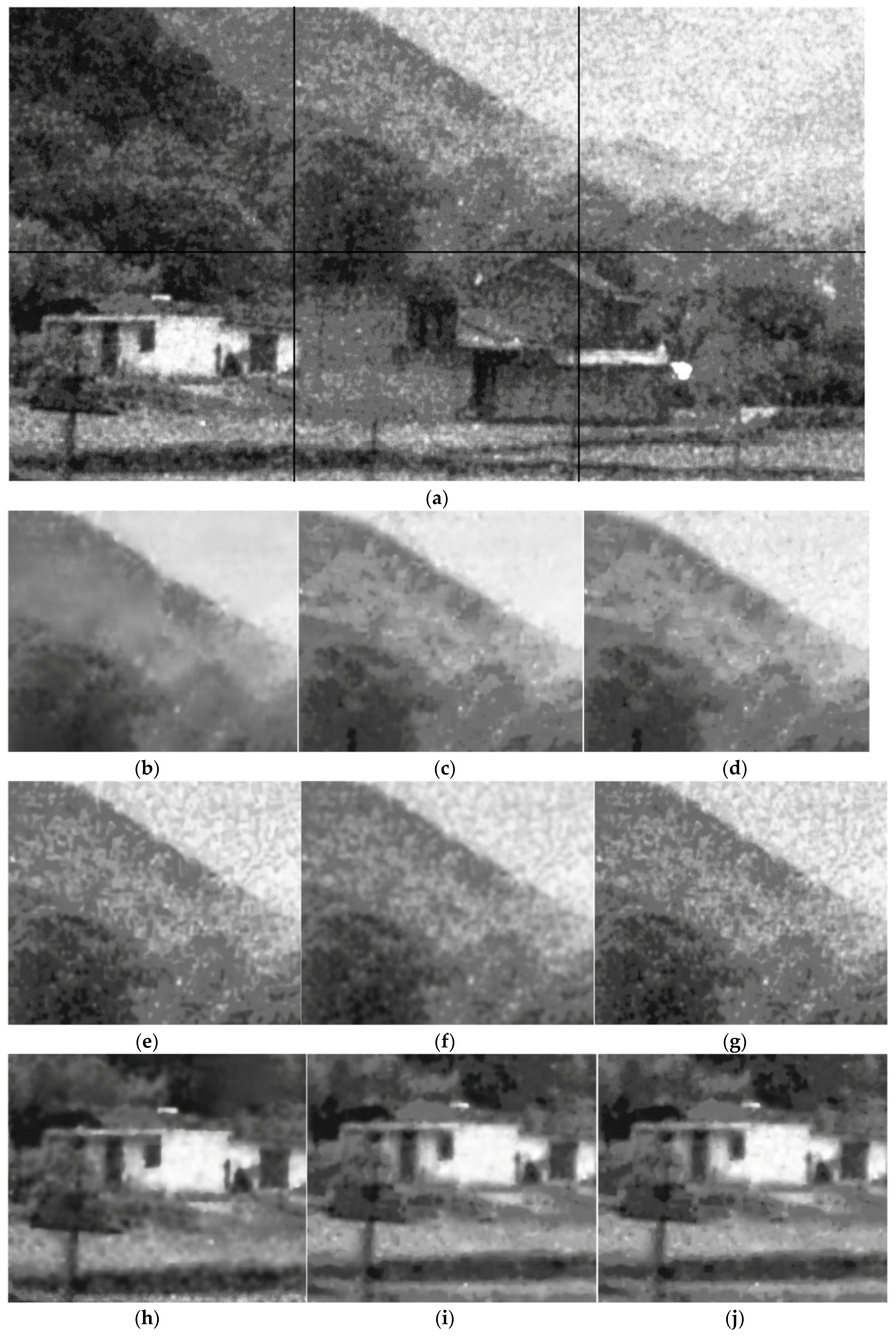


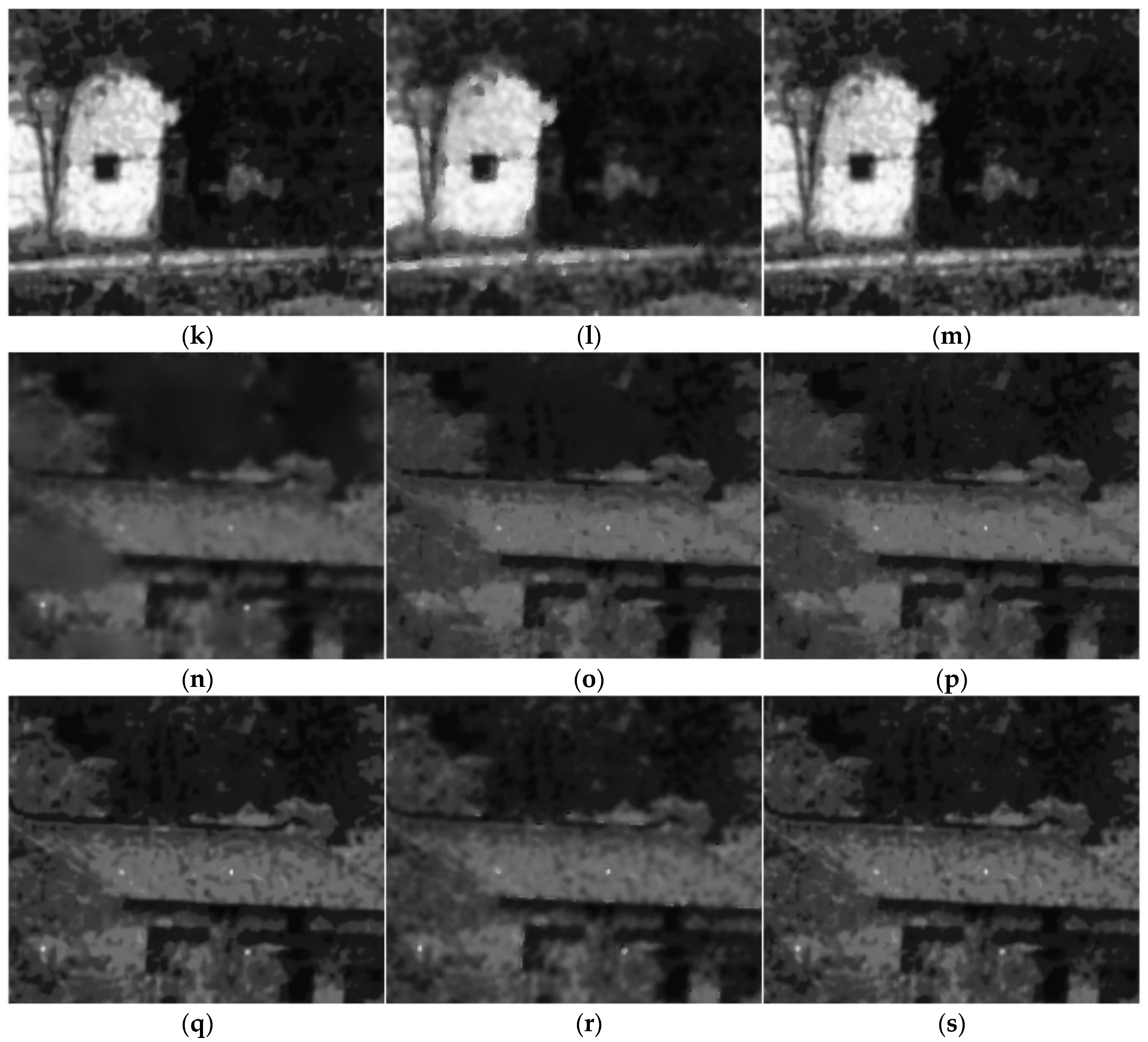

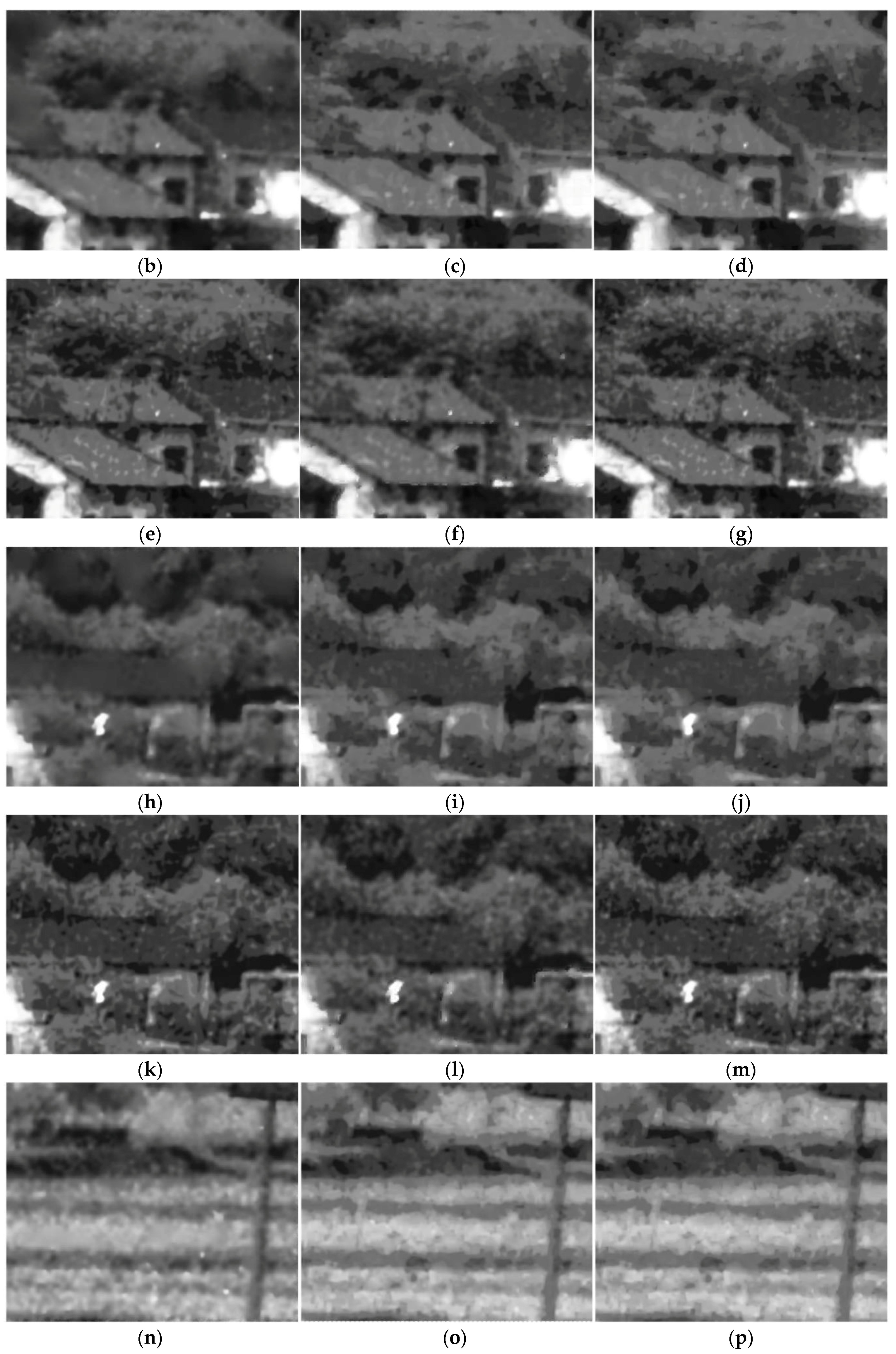

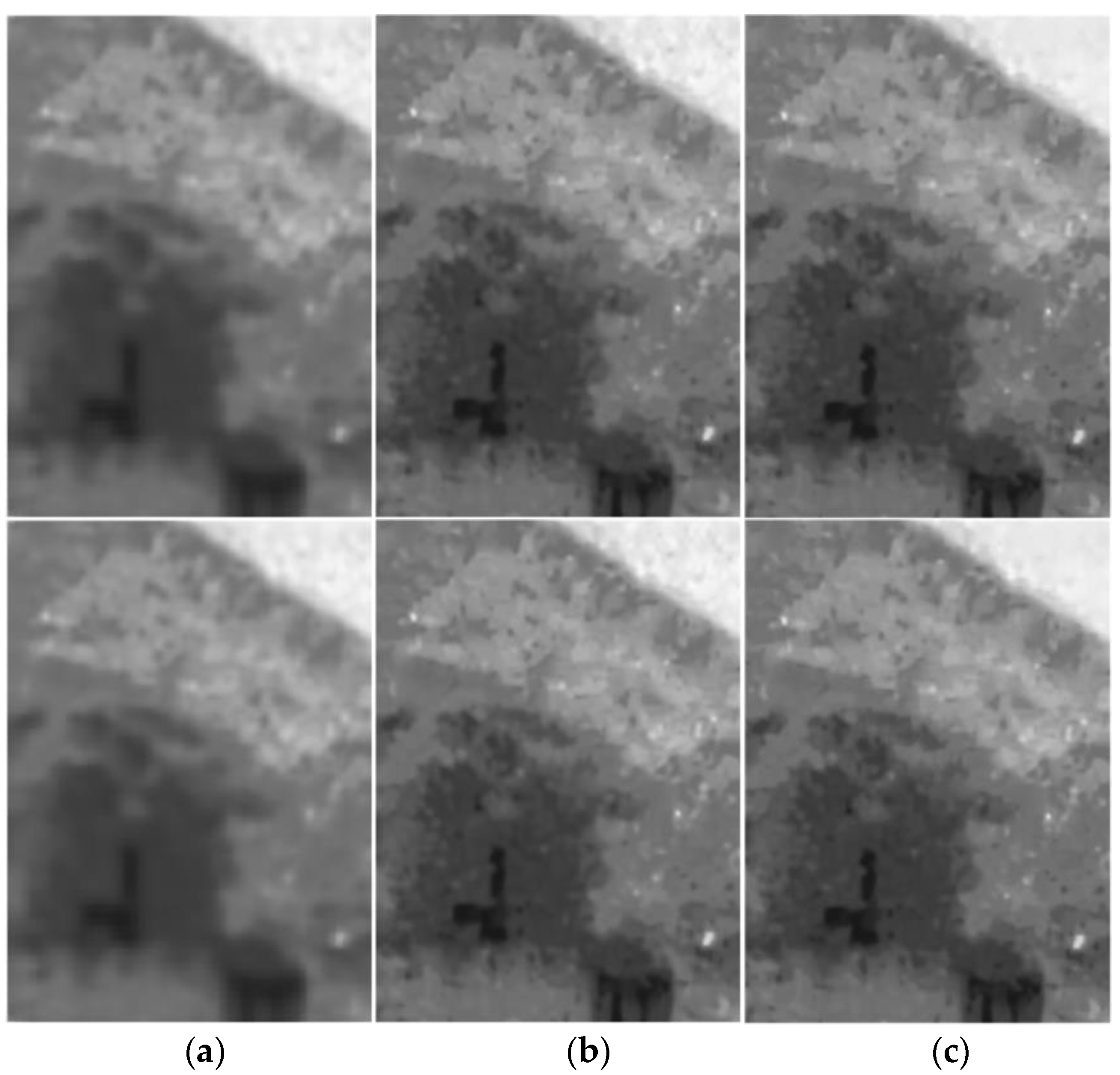
| n | m | PSNR (db) | n | m | PSNR (db) | ||
|---|---|---|---|---|---|---|---|
| 2 | 2 | 0.1 | 73.19995 | 3 | 2 | 0.1 | 73.21281 |
| 2 | 2 | 0.2 | 73.18212 | 3 | 2 | 0.2 | 72.95117 |
| 2 | 2 | 0.3 | 73.11725 | 3 | 2 | 0.3 | 73.19301 |
| 2 | 2 | 0.4 | 73.19670 | 3 | 2 | 0.4 | 73.28845 |
| 2 | 2 | 0.5 | 73.11630 | 3 | 2 | 0.5 | 73.42306 |
| 2 | 3 | 0.1 | 73.28173 | 3 | 3 | 0.1 | 73.04053 |
| 2 | 3 | 0.2 | 73.18228 | 3 | 3 | 0.2 | 73.20538 |
| 2 | 3 | 0.3 | 73.32812 | 3 | 3 | 0.3 | 72.88833 |
| 2 | 3 | 0.4 | 73.22885 | 3 | 3 | 0.4 | 73.32938 |
| 2 | 3 | 0.5 | 73.14801 | 3 | 3 | 0.5 | 73.19522 |
| 2 | 4 | 0.1 | 73.04365 | 3 | 4 | 0.1 | 73.13615 |
| 2 | 4 | 0.2 | 73.11540 | 3 | 4 | 0.2 | 73.19505 |
| 2 | 4 | 0.3 | 73.34357 | 3 | 4 | 0.3 | 72.81382 |
| 2 | 4 | 0.4 | 73.12557 | 3 | 4 | 0.4 | 73.14337 |
| 2 | 4 | 0.5 | 73.20798 | 3 | 4 | 0.5 | 72.86815 |
| 2 | 5 | 0.1 | 73.11540 | 3 | 5 | 0.1 | 73.19301 |
| 2 | 5 | 0.2 | 73.17220 | 3 | 5 | 0.2 | 73.22224 |
| 2 | 5 | 0.3 | 73.03383 | 3 | 5 | 0.3 | 72.78663 |
| 2 | 5 | 0.4 | 73.18219 | 3 | 5 | 0.4 | 73.15062 |
| 2 | 5 | 0.5 | 73.21231 | 3 | 5 | 0.5 | 73.17858 |
| 4 | 2 | 0.1 | 73.20403 | 5 | 2 | 0.1 | 73.17788 |
| 4 | 2 | 0.2 | 73.17530 | 5 | 2 | 0.2 | 73.19318 |
| 4 | 2 | 0.3 | 73.03849 | 5 | 2 | 0.3 | 73.13893 |
| 4 | 2 | 0.4 | 73.21268 | 5 | 2 | 0.4 | 73.03510 |
| 4 | 2 | 0.5 | 72.79888 | 5 | 2 | 0.5 | 73.13128 |
| 4 | 3 | 0.1 | 73.19837 | 5 | 3 | 0.1 | 73.14298 |
| 4 | 3 | 0.2 | 73.02988 | 5 | 3 | 0.2 | 73.14298 |
| 4 | 3 | 0.3 | 73.20614 | 5 | 3 | 0.3 | 73.07012 |
| 4 | 3 | 0.4 | 73.21402 | 5 | 3 | 0.4 | 73.20198 |
| 4 | 3 | 0.5 | 73.11114 | 5 | 3 | 0.5 | 73.13739 |
| 4 | 4 | 0.1 | 73.34665 | 5 | 4 | 0.1 | 73.19715 |
| 4 | 4 | 0.2 | 73.23437 | 5 | 4 | 0.2 | 73.08766 |
| 4 | 4 | 0.3 | 73.17264 | 5 | 4 | 0.3 | 73.03212 |
| 4 | 4 | 0.4 | 73.17855 | 5 | 4 | 0.4 | 73.11872 |
| 4 | 4 | 0.5 | 73.15255 | 5 | 4 | 0.5 | 73.0394 |
| 4 | 5 | 0.1 | 73.16033 | 5 | 5 | 0.1 | 73.16033 |
| 4 | 5 | 0.2 | 73.22001 | 5 | 5 | 0.2 | 73.19837 |
| 4 | 5 | 0.3 | 73.19912 | 5 | 5 | 0.3 | 73.14524 |
| 4 | 5 | 0.4 | 73.30515 | 5 | 5 | 0.4 | 73.00673 |
| 4 | 5 | 0.5 | 73.13857 | 5 | 5 | 0.5 | 73.24143 |
| Average Runtime | |
|---|---|
| The algorithm in [2] | 86.3 |
| The proposed algorithm without the RPCA | 5.4 |
| The proposed algorithm with the RPCA | 57.2 |
© 2017 by the authors. Licensee MDPI, Basel, Switzerland. This article is an open access article distributed under the terms and conditions of the Creative Commons Attribution (CC BY) license (http://creativecommons.org/licenses/by/4.0/).
Share and Cite
Yang, M.; Wang, F.; Wang, Y.; Zheng, N. A Denoising Method for Randomly Clustered Noise in ICCD Sensing Images Based on Hypergraph Cut and Down Sampling. Sensors 2017, 17, 2778. https://doi.org/10.3390/s17122778
Yang M, Wang F, Wang Y, Zheng N. A Denoising Method for Randomly Clustered Noise in ICCD Sensing Images Based on Hypergraph Cut and Down Sampling. Sensors. 2017; 17(12):2778. https://doi.org/10.3390/s17122778
Chicago/Turabian StyleYang, Meng, Fei Wang, Yibin Wang, and Nanning Zheng. 2017. "A Denoising Method for Randomly Clustered Noise in ICCD Sensing Images Based on Hypergraph Cut and Down Sampling" Sensors 17, no. 12: 2778. https://doi.org/10.3390/s17122778




